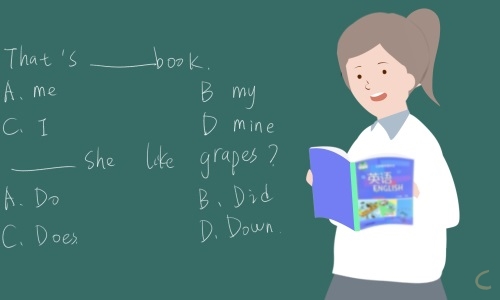中班英语课教案(18篇)
教案能够帮助教师提前预测学生可能遇到的问题,并做好解决方案。下面是小编为大家整理的中班英语课教案,如果大家喜欢可以分享给身边的朋友。

中班英语课教案(精选篇1)
教学目标:
1、听懂、理解并会说出单词“bird”、“frog”、“monkey”。
2、学会使用句型“I can see……”进行表达。
3、鼓励幼儿能模仿教师说英语。
4、乐意参加英语活动,对英语活动感兴趣。
教具准备:
ppt课件、单词卡片、一棵大树、自制动物各一个、望远镜3至4个。
教学过程:
(一) 热身活动:
1、韵律歌曲《walking jumping running》边唱边跳进场。
2、GreetingT:Hello,what’s your name?
S:I’m __。
T:Hello, __。
S:Hello,Miss Liu。
简单的对话操练几遍。
(二)单词学习
1、播放ppt,让小朋友猜一猜是什么东西在叫。(鸟叫声)。ppt出示鸟的图片teach“bird”
2、教师领读,小朋友跟读,(采用游戏的方式进行练习,让小朋友一边说单词,一边用头顶单词卡片)
3、用相同的方法教授另外两个单词:frog和monkey
(三)游戏:《说一说,做一做》
规定好鸟、青蛙、猴子的动作,老师说一个动物单词,小朋友需要迅速做出该动物的动作,同时重复英语发音,看谁做得又快有准。
(四)句型学习
1、出示一棵大树,在树上贴好自制的鸟。
教师出示望远镜,并说:I can see a bird。 (小朋友跟读)。
用准备好的望远镜给小朋友上来表演,并准确说出句型“I can see a bird”
3、在树上贴好猴子,在树下贴上青蛙。
让小朋友自己来说一说,操练句型“I can see。”说出:“I can see a monkey。”“I can see a frog。”
(五)游戏《What’s missing》
1、播放ppt,出示三个动物,让小朋友分别说出三个单词。
2、播放ppt,消失一个动物,让小朋友说出那个动物单词,并用句型说出“I can see…”
3、相同的方法操练。
(六)chant用三个动物的.动作,叫声以及相应的单词编一首chant,让小朋友跟着做,边做边退场,结束课程。
附:chantBird bird bird 啾啾啾 (飞的动作)Frog frog frog 呱呱呱(跳的动作)Monkey monkey monkey 叽叽叽(猴子抓头挠耳)
中班英语课教案(精选篇2)
活动目标
了解各种昆虫的特性
活动准备
4种昆虫挂图、介绍各种昆虫的材料、投影仪、玩具锤子
活动过程
一、Warm up
“Hello everyboby !Let’s sing a song ,OK?”——Sing a song (BINGO)
二、Topic
师:“孩子们,今天老师给你们带来了4只昆虫朋友,你们想不想看看它们?”
师:“咱们先来看看第一位是谁?”
1、 学习ant
出示ant卡片
师:“孩子们,你们认识这是什么昆虫吗?”
师:“对,是蚂蚁,那你们知道蚂蚁的`英语怎么说吗?”
2、请幼儿跟读几次,注意n的发音,还要发一个清晰的t音。
师:“你们看ant的最上面的两只手是不是横着放的,那咱们来学学他们横着放的样子。”
3、模仿ant 的动作
4、学习cockroach、fly、mosquito同上。
三、Excise
中班英语课教案(精选篇3)
一、情况分析
本班幼儿活泼好动,基本的英语词汇较丰富,教师将通过创设情景并演示教具,让幼儿在一种自然的表演中感受、理解动词,学习动词,愿意用动作来表现自己所知道的动词。
二、活动内容
在游戏的过程中复习已学过的单词并学习新单词,在活动中反复地练习,学习说“What can you do?”并能用“I can…” 回答。
三、活动目标
1、在游戏活动中复习已学过的动词, 愿意跟随教师一起念儿歌。
2、能听懂What can you do?并能用“I ca…” 回答。
四、活动准备
蝴蝶、鸭子、兔子、鱼、狗的'图片及头饰。
五、活动过程
(一)warm up[热身] Follow Me :
Follow me, walk stop.
Follow me, jump stop.
Follow me, cry stop.
Follow me, laugh stop.
Follow me, stand up.
Follow me, sit down.
(二)resection[呈现主题]
1、复习单词:fly,walk.
T:Look. What can I do? (做相应的动作)I can fly(walk)。 Fly, fly, fly. I can fly. Walk, walk, walk. I can walk.(边说边做动作)
T:Now, everybody stand up and follow me. Follow me, fly, fly, fly. I can fly.(walk)(幼儿跟随教师边说边做动作)
2、通过图片和动作表演让幼儿理解 what can it do的含义。
出示蝴蝶和鸭子的图片:
T:What can it do? It can ……(做动作等待幼儿回答),Fly, fly, fly, it can fly.
C:Fly, fly, fly, it can fly.
3、学习新单词:skip, swim, run
分别出示兔子、狗、鱼的图片:
T: What can it do?
C: It can ……(边说边做相应的动作)
(三)practice[练习] T:Who is it? (教师随意出示动物图片,幼儿说出相应的单词)
T:What cait do? (教师出示图片,幼儿做出相应动作并说出It can……)
(四)reduction[应用]
1、请幼儿选择一个小动物,并说出:I’m ……,I can ……
2、请幼儿选择旁边的一个小朋友为一组,两人互相问答:What can it do? It can ……
六、结束放松
请幼儿戴好头饰,放音乐边念儿歌边走出教室:Fly, fly, fly, I can fly. Swim, swim, swim, I can swim……
中班英语课教案(精选篇4)
活动目标
1、启发引导幼儿学会banana, bread, egg, milk的正确发音。
2、培养幼儿从小热爱英语和学习英语的自豪感。
3、重点难点:重点让幼儿在愉悦中记住单词并尽可能的学习正确的发音。难点是会和老师进行简单的英语对话。
活动准备:
1、多媒体课件
2、放录象
3、自制彩色卡片
活动过程:
(一)开始部分 (课堂导入) (3分钟)
1、复习上节课学过的单词apple, peach, pear, orange.
2、老师出示实物(苹果、桃子、梨、橘子)和小朋友简单对话。如:What’s this? It’s an apple. 对话完毕。师:小朋友,今天老师再和小朋友学习4个英语单词好不好?
(二)基本部分:(15分钟)
1、老师出示实物。先让小朋友说出它们的汉语名称:香蕉、面包、鸡蛋、牛奶。
2、师一一说出它们的英语名称banana, bread, egg, milk连读三遍。然后教小朋友反复读三遍。
3、录象:师:小朋友,下面老师放一段录象“ 一顿早餐”。小朋友看时要仔细听,仔细看,里面几句话我们已经学过了。(跟着学一学,看外国人的发音)听一听里面讲没讲今天学的新单词。并跟着学一学。(大致内容:一个外国小朋友Jack早上来到餐桌前首先问:Good morning, mum. Good morning, dad. 爸爸妈妈:Good morning, Jack. 问候后Jack开始用餐,餐碟里有一个香蕉,两片面包,一个鸡蛋,一杯牛奶。Jack一边吃一边有配音解释。用完早餐,Jack背上书包去上学。Jack: Goodbye, dad. Goodbye, mum.爸妈:Goodbye, Jack. 然后把动作定格,连读三遍,banana, bread, egg, milk. 这时小朋友可跟随发音)
a)放课件:让小朋友看大屏幕,在欣赏动画的过程中再次巩固记忆新单词。( banana, bread, egg, milk. )
b)学习简单对话:放课件:如:What’s this? It’s a banana.
c)老师出示实物和小朋友反复对话,突破难点。
(三)结束部分:(10分钟)组织小朋友游戏,在游戏过程中让小朋友巩固所学单词。
老师在“宝贝袋”(里面有香蕉、面包、鸡蛋、牛奶、苹果、梨、橘子、桃)一位蒙上眼睛的.小朋友站在中间,其他小朋友围成大圆圈,手拉手,一边跳,一边转,高声喊:“某某某,你真行,不用看,能猜中。One, two, three.”老师从口袋里摸出一样东西,蒙眼的小朋友用英语猜出老师手里摸到了什么,若猜中了就送给他,其他小朋友再次喊,另一小朋友再次摸,游戏继续进行。若猜不中,就摸一个小朋友猜一猜他是谁。强调:小朋友在愉快游戏中,要动脑用英语猜老师手里摸到什么,在轻松愉快中巩固了所学知识。
(四)小结:(1分钟)
老师总结评价本次活动。表扬表现好的小朋友。对一些表现不够好的小朋友指出批评。(用引导性语言)
活动结束:
教小朋友回家给邻居家的小朋友当老师,把你学到的英语单词教给他们。
中班英语课教案(精选篇5)
活动目标:
1、掌握单词的正确发音。
2、理解句子。
活动准备:
1、爷爷奶奶的图片各一张。
2、一些小礼物
3、配套磁带
活动过程:
一、问好,做律动《how do you do》。
1、t:good morning ,boys and girls.
now ,let’s do the actions,are you ready?
c:yes.(师幼一起律动。)
2、复习pencil pencil-box knife rubber
二、学习新内容
1、导入
t:boys and girls ,there are two pictures.
look at the first picture.
guess.who is he?
c:爷爷
t:grandpa
c:grandpa
2、借助动作学习单词。
t:boys and girls,stand up and follow me “grandpa”。(边说边做动作)
c:“grandpa”(边说边做动作)
3、全体幼儿一起做动作。
t:let’s do the actions.
i say you do .are you ready?
c:yes.
t:grandpa/grandma.
c:幼儿做动作
t:,come here,please,i say ,you do.
t:grandpa/grandma.
c1:幼儿做动作。
t:this time .i do you say.
c:grandpa/grandma.
三、学习句子:配班教师扮演爷爷、奶奶。
t 1&t 2:may i come in?
t:come in,please.
t 1&t2:hello,boys and girls.
t:this is my grandpa.
this is my grandma.
四、结束活动:分发礼物
中班英语课教案(精选篇6)
活动目的:
通过反复感受,理解问句“What do you see?";学习用句型" I see….",表达所看见的内容。
通过多种形式的操作、摆弄,激发幼儿参与英语活动的`兴趣,鼓励幼儿开口说英语。
活动准备:
捉迷藏背景图
大转盘,图片
人手一份操作用具
活动过程:
一、复习
1、歌曲《Hello!》
2、游戏《快乐郊游》
3、招呼语
二、看图片,感受并理解对话:
T: Look! What do you see?
I see a ra it / a m&;#111nkey / a duck / two elephants.
三、欣赏儿歌、歌曲《What Do You See?》。
四、游戏《大转盘》:
教师旋转转盘后,幼儿根据指针的指向,尝试集体输出" I see …."
五、游戏《传球取宝》:
幼儿听音乐传球,音乐停,持球者击破纸面取出宝物,并集体说:" I see …."
六、分组操作游戏:
(教师提供:转盘、魔方、图书、彩色眼镜等)幼儿边玩边尝试个别输出" I see …."
中班英语课教案(精选篇7)
一、活动目标:
1、 幼儿能够理解“I like…”和“I don’t like…”的中文含义。
2、 在教师的引导下,幼儿能够大胆地使用“I like …”和“I don’t like…”的句型。
3、 幼儿能积极参与到游戏活动之中,能与小朋友教师进行互动。
二、活动准备:
1、 蔬菜卡片:carrots, cucumbers,tomatoes,potatoes,peppers(后面贴上双面胶以便于贴在黑板上展示。)2、 5个蛋糕盘子3、 1个手提篮4、 1个垃圾桶5、 1个爱心,1个哭脸以及哭脸和爱心的大转盘三、活动过程:
1、 问候:Good morning/How are you?/How do you do?/Nice to meet you…通过问:“Which colour/fruit/food/season/vegetable do you like best?”引出vegetable:carrots, cucumbers,tomatoes,potatoes,green and red peppers.
2、 询问“What is this?”将蔬菜全部陈列粘贴在黑板上。
3、 教师挎着篮子说“Today , I’m very happy, Iwant to go shopping to buy some vegetable.”走到陈列着蔬菜的黑板前说:“I like carrots, cucumbers,tomatoes,potatoes,peppers”亲一亲蔬菜卡片,并将卡片放进篮子里。
4、 教师将卡片一一从篮子里拿出来,拿出一个放进蛋糕盘子里就说:“I like … yummy!”请幼儿上台表演“I like … yummy!”
5、 教师愁眉苦脸地将盘子里的`蔬菜倒进垃圾桶里,边倒边说:“I don’t like…”再请个别幼儿上台表演。
6、 在黑板上粘贴爱心和哭脸,教师将图片贴到爱心下就很开心的说:“I like …”,将图片贴到哭脸下就说:“I don’t like…”教师任意指出其中一个图片,让幼儿用“I like …”和“I don’t like…”的句型进行表达。
7、 请幼儿上台将喜欢的蔬菜贴在爱心下,不喜欢的蔬菜贴在哭脸下,并用“I like …”和“I don’t like…”将其表达出来。
8、 教师呈现“哭脸和爱心的大转盘”,将蔬菜贴在转盘的周围,转到哪就请幼儿用英语表达出来,再请幼儿上来旋转,进行英语表达。
9、 唱英文歌曲:“Three little bears”,活动结束。
中班英语课教案(精选篇8)
一、活动目标
1、幼儿能够用英文和他人进行基本情景对话;
2、感受情景游戏中英文对话的乐趣。
二、活动准备
桌子一张,椅子五把,水果蔬菜模型若干个,食物卡片
三、活动过程
1、Roy 带着新朋友到Eason家做客
Roy:叮咚......
Eason(打开门):Good morning,everyone!
Kids:Good morning!
Eason: come in ,please!
Eason带着大家来到客厅——
Eason:How are you,Roy?
Roy:I’m fine,thank you!And you?
Eason:Welcome to my home.I’m Eason,I’m six.
Lena:Hello, Eason,I’m lena,I’m five.
Lucy:Hello, Eason,I’m lucy,I’m six,too
Eric:Hello, Eason,I’m eric,I’m five.
Eason:Sit down,please!
Eason去厨房拿准备好的水果模型和卡片,放在桌子上
Eason:What do you want,Roy?
Roy:I want some noodles.
Eason拿起面条的卡片给Roy
Eason:Here you are!
Roy:Thank you!
Roy: What do you like ,Lucy?
Lucy:I like pear
Roy:A pear for you!
Lucy:Thank you!
Eason:What do you want,Lena?
Lena:I want some dumplings.
Eason拿起面条的卡片给Lena
Lena:Thank you!
Lucy: What do you like ,Eric?
Eric:I like potato
Lucy:Here you are!
Eric:Thank you!
大家一起拿着各自喜爱的东西在吃......
2、这时候,大家都吃得差不多的时候,Eason拿出了mummy买的'动物头饰,要和大家一起做游戏
Eason:Ok.look!mummy 买了好多小动物的头饰给我,Let’s play games .ok?
Kids:ok!
Roy:我要当tiger.
Lucy:我要当bear
Lena:我要当lion
Eric:我要当pig
小朋友们都各自带上小动物头饰,站成一排,由Eason来说:This is a tiger,this is a lion,this is a bear,this is a pig
Ok,现在各自扮演的动物都表演一段who say.......
儿歌“who says”各自表演......
3、表演结束
Lucy:I want to wash my hands...
Eason:Ok!(带着lucy去洗手)
Eric:Look!I can hop!
Kids:Very very good good!
Lena:I can draw...(模拟画画动作)
Eason:Do you like football?baskeball?bowling?pingpong?
Kids:Yes, we do....
Eason 拿出各个体育用品卡片送给大家,作为今天大家来做客的礼物....
Eason:Ok,good bye!Everyone!
Kids:See you tommorrow,Eason。
中班英语课教案(精选篇9)
一、活动目标:
1、熟悉各种动物,掌握单词tail(尾巴)tiger(老虎),进行简单的数学配对。
2、培养幼儿的`观察潜力、决定潜力。
3、培养幼儿热爱、关心、爱护小动物的情感
二、活动重点:区分各种动物的尾巴,进行简单的配对。
掌握tail,tiger。
三、活动难点:
幼儿能与老师互动,领会老师的问题并做出相应的回答。
四、重难点解决方法:
通过课件及动物图片,教师示范,引导幼儿反复跟读掌握发音,理解意思。
五、活动准备:
教学课件、自制动物的图片
六、活动过程:
1、 Greeting
T:Good morning,boys and girls。 How are you today? Are you ha y?(幼儿回答)
2、 Warmup
Lets have a warm up,ok? Follow Melody。(与幼儿一起做热身运动)
3、New learning
通过反复利用动物课件学习单词tail。
Today,Melody will introduce five friends to you. Look! Whos ing?(出示课件)This is my tail,I can swim. Who am I? Yes,Im fish。Hello!
依次出示狗(I can woof. Im dog.)、兔子(I can jump.Im ra it.)、孔雀(Im beautiful. Im peacock.)
完整出示四个动物,进一步加深印象。同时引出tiger。
点数后:Whos not here? Oh,tiger。Wheres tiger?(tiger)出示哭的tiger。
帮忙tiger找尾巴,进一步学习tail、tiger。
出示动物教具,幼儿动手操作,为动物找尾巴。
4、ENDING
教师做出评价,动物向孩子们说Thank you。
中班英语课教案(精选篇10)
活动目标:
1、了解一些常见蔬菜的名称和特征。(西红柿Tomato、黄瓜cucumber、玉米Maize, 胡萝卜Carrot)
2、引导幼儿运用多种感官感知蔬菜的特征。
活动准备:
图片
活动过程:
一、复习水果Fruit
T:Yesterday,we have gone to fruit’s home. We has known the apple , banana , Orange and pear, do you also remember them?
S:yes!
T:ok!Now let me test you !(教师出示图片,问)
Please take a picture. What is this? Is this a fruit? Let the vegetables gone here to line up. All these are fruit, all these are vegetables.
二、认识蔬菜
1、认识蔬菜、了解特征
T:This is …….
1)What color is it?(在黑板上画出颜色)
2)What sample is it?(在黑板上画出样子)
T:This is a tomato / Cucumber / Maize / Carrot.
It is red / green / yellow / Orange.
It is Round / long、Curved弯 / small、One for one一粒一粒 / long、Thick粗.
中班英语课教案(精选篇11)
一、教学目标
1.使幼儿能掌握字母和单词的发音
2.能正确理解句型的含义
3.踊跃地参加游戏,大胆大声的'读出来
二、教学重点与难点
1.字母及单词的拼读与书写
2.句型的含义及运用
三、教学内容
1.字母:Oo Pp
2.单词:daddy(爸爸)mami(妈妈)
3.句型:
四、教学准备
字母卡片、单词卡片
五、教学过程
1.复习单词及字母:请学生认读学过的卡片
2.学习字母:Oo Pp
3.教学游戏:“超级打手”。将字母或单词写在黑板上,请2—3名同学到黑板前,背对黑板站好,老师说出一个字母或单词,小朋友迅速转身。用教棍击中老师所说的字母,并重复说出字母。
4.学习单词daddy mami
5.教学游戏:“开火车”游戏。老师是火车头,提问:“what is that? ”小朋友用句型“That is ……”来回答。游戏反复进行,直至所有的学生都上到火车。
6.跟老师读单词和字母
a)全班学生跟老师读
b)游戏“大小声”读
c)男女生读
d)个别学生读
六、练习
让学生在练习本上写字母和单词。
七、作业
每个字母和单词写2行。
中班英语课教案(精选篇12)
活动目的:
1、初步学习谜语儿歌“Kangaroo”,能够讲述袋鼠的基本特征。
2、学习单词grey、pocket,正确认读和区分grey和green的发音。
活动准备:
大布袋一只,彩盒一个。袋鼠图片以及彩色的'袋鼠词性拼图。
预设活动过程:
1、出示大口袋,带领幼儿学习pocket。
T:What is this?
T:Pocket,This is a pocket.
T:am
C:Pocket,Pocket,This is a pocket.
2、取出口袋中的大彩盒,引导幼儿抛彩盒,学习grey。
T:This is a color square.There are many colors on It. What color is it?
C:White Brown Blue Black Green.
T:What color is it?
T:Yes,grey,grey,grey,grey.
T:I see…Who will try?
3、复习韵律儿歌“I see…”
T:We see green,black,grey…Now,Let is read the rhyme“I see…”,One,two,start。
4、引导幼儿学习谜语儿歌“Kangaroo”,初步感知和理解儿歌的内容。
T:I am grey.I can jump,What am I?
T:I am grey,I have a big pocket.I can jump,What am I?
5、猜谜游戏活动:
T:What are you?
T;am C:I am grey,I have a big pocket,I am…What am I?
中班英语课教案(精选篇13)
活动目标:
1、学习新单词 daddymammysistherborther
2、复习常用语 good morning
3、在游戏中体验学习的乐趣。
活动准备:
四个房子、 bobo熊、律动音乐、录音机、单词卡片
活动过程:
1、(worm up)热身运动
(1 ) 打招呼 good morning
(2 ) hallo ,hi 游戏
2、new words (新授)
(1)出示bobo熊,打招呼
师:你们知道这是谁的家吗?
(2)游戏:敲门
请幼儿敲门,幼儿边发出咚咚咚的声音边将门打开!
请幼儿将daddy 喊出来,认识一下daddy的形象:抽着烟斗的!
请幼儿大声得将daddy喊到房顶上去。
依次进行(过程中可以请幼儿单独敲敲)
3、lisenning game (听力游戏):轮流
小椅子上放单词卡片,请四名幼儿分别扮演daddy mammy sisther borther ,蹲在小椅子背后,教师在后面指挥,下面的幼儿根据教师的指挥说英文,相对应的幼儿把头漏出来!
4、speaking game (说的游戏) :捉迷藏
四名幼儿拿着卡片躲在房子后面,请下面的幼儿猜测家里的人,猜对了幼儿就会从房子里出来!
5、dance (律动):my family
6、goodbye
Go home , to be a little teacher , tell you daddy and mummy what you lernr today 。
课后反思:
1、英语游戏的合理选择和贴切运用
我选择符合幼儿年龄特点的游戏,使他们产生极大的兴趣,在积极的游戏活动中习得英语,小班孩子以有趣的教玩具来激发他们的兴趣, 英语教学游戏化是使幼儿对英语习得的过程变得愉快、有趣、轻松及充分发挥幼儿学习的主体性,所以我以游戏的形式展开。选择了适合幼儿和教学内容的游戏形式!
2、广泛的英语游戏形式
整个活动我选用了三个游戏,新授时设计的敲门游戏显然孩子们很兴奋,在通过学动作、喊出来、吹到房顶上的活动给孩子说的机会,加深新单词的印象。听的游戏在于让幼儿能根据教师(幼儿)的口令进行,这一环节应该是孩子们很感兴趣的,由于是新授的,所以孩子在说的时候有点困难,如果在让下面的孩子说之前教师先示范,可能效果会更好!说的'游戏让孩子从房子里钻出来吸引幼儿的兴趣,目的在于巩固幼儿对单词的认识,又给幼儿提供了一次说的机会!律动也是相对应的 my family , 给幼儿放松的时间动起来!
3、存在的不足
在听力游戏的时候应该以听为主,我请下面的幼儿做指挥显然是有点困难的,如果在请幼儿做指挥前教师师范一下加深印象我想效果会更好!
中班英语课教案(精选篇14)
活动目标:
1、对英语游戏感兴趣并能积极参与。
2、学习单词hamburger和chicken,复习巩固句型。
3、能听懂并理解英语指令和教学用语。
4、大胆开口说英语,体验英语的乐趣。
5、理解词语含义,发音准确。
活动准备:
KFC的场地布置、卡片、玩具若干、汉堡鸡腿等
活动过程:
一、导入Go to KFC
Boys and girls,do you want to go to KFC?
Riding in my car,ok?Let’s go!
二、新授单词Hamburger,chicken
Here it is!This is KFC,come in please!Welcome to KFC,sit down please.
I am an assistant and prepared some food for you.
端出一盆,拿出汉堡包问:What’s this?用不同声调说hamburger,Touch the hamburger please。拿出鸡腿问:Whats this?Touch the chicken please.
It’s chicken,yes or no?It’s hamburger,yes or no?
同时出现hamburger chicken/ Touch the hamburger/ chicken please.
三、用卡片巩固所学单词
There are some cards under your chairs,take them out please.Let’ play a game.
(1)I say you do
If I say chicken/ hamburger,you can put up the chicken/ hamburger’s card.
(2)I’ll put up the cards,you say it.
(3)__,come here please,you say,we do it.
游戏(一)buy someing,巩固所学单词及句型
Oh,I am very very hungry,are you hungry?Lets buy something OK?Miss zhao,come here please.Now,Look at us carefully,Let’s begin 。
教师示范:Hello,Miss zhao!Hello,assistant,can I help you?hamburger please.Ok,here you are.Thank you.
Who wants to buy something?
Who wants to be an assistant?Ok,you are very very clever.
幼儿进行情景对话练习
Look,I have a big box,there are many many toys in it?Do you want to have a toy?__,swim to me./walk to me like a cat./Skip to me like a rabbit./Fly to me like a bird./Run to me like a dog.
四、结束
oh,it’s later now,let’s go home.Riding in my car.
中班英语课教案(精选篇15)
活动目标:
1、复习颜色单词:red yellow .
2、学习颜色单词:gree go stop
3、通过游戏初步学会句型:Let’s go! Stop !
活动准备:
红、黄、绿、三色卡片、红、绿交通灯信号牌
游戏音乐磁带。红、黄、绿三色塑料圈(当方向盘)若干。
马路上交通情景录象。
活动过程:
一、幼儿随音乐和教师律动进入活动室。
二、通过游戏复习并学习颜色:red yellow green
1、教师出示红色和黄色卡片,提问:“What colour is it?”请幼儿回答。
2、教师出示绿色的卡片,提问“What colour is it?”教幼儿绿色的英语green.并引导幼儿:“你见过的什么东西也是绿色的?”
3、引导幼儿观察自己或同伴身上的衣服或活动室内的玩具、装饰、气球,找一找哪里有红、黄、绿三种颜色。
4、根据老师出示颜色卡片的提示演唱歌曲《What is the colour》。
三、通过游戏学习句型:
1、交通灯。
(1)、教师先请幼儿观看马路上的交通情景的'录象。请幼儿讨论
师:看过了录象,你发现了什么规则?当红灯亮的时候,汽车怎么了?绿灯亮时,汽车又怎么了?
请幼儿一边看录象一边听老师讲,并学习新单词:go、 stop
(2)、教师扮演交通警察,幼儿当汽车司机。当红灯亮时,汽车要停下,当绿灯亮时,汽车就可以开了。
(3)、请一幼儿当交通警察,教师带领其他幼儿当司机。看到红灯时,教师引导幼儿一起说:“Stop!”。当看到绿灯时,幼儿跟着教师说:“Let’s go!”。
(4)、请另一位幼儿当交通警察,游戏反复进行。
2、开汽车。
教师请幼儿自由选择方向盘,并提问:“What colour is your car?”
幼儿根据自己方向盘的颜色回答老师。并随着音乐自由开车。当看到老师举起绿色交通信号牌时,幼儿们一起说:“Let’go !”
随音乐开车出活动室。
四、结束。
在游戏中自然结束。
中班英语课教案(精选篇16)
Teaching Objectives:
Students should understand the meaning of reading, master useful expressions and learn more about the present perfect tense.
Language Focus:
Useful topic: Surfing, beaches; useful expressions: have been, never, ever, no matter how, neither nor, etc; and other reading skills.
Properties:
Tape recorder, topic cards, answer sheet, etc.
Teaching Procedures:
I. Revision
Revise the Present Perfect tense, do the exercise 2 on page 97, ask students answer the questions one by one.
II. Pre-reading
There are many kinds of water sports, such as swimming, paddling, Boogie-boarding, and dragon boat race in China. What water sports have you watch? What kind of water sport you like best, why?
III. While-reading
Before first listening of Surfing, read the questions of exercises 1 on page 98. Prepare their answer sheet. Ask the students bring these questions to listen the tape or video first time. Write their answer if possible.
Then play the tape or video once again, ask the students check their answers. And then let them try to give the main sentence of this reading.
Open the textbook, turn to page 7. Let Ss find the new words and useful expressions in five parts (each part for each paragraph). Ask them give correct explanation. Make sure everyone is on task. While working, teacher go around the classroom and give help where need. Then show the answers of them. Teacher explains the main sentences, such as Now it is enjoyed by people all over the world; It's neither too hot nor too cold all the year round; etc.
IV. After-reading
Discussing in four parts, talk about San Francisco, Honolulu, Hawaii, Hainan island. After discussion Ss should give Where is it, What it famous for, What water sport are there, etc.
V. Homework
1. Finish exercises 2 on page 98.
2. Revise the new words, useful expression and sentences
中班英语课教案(精选篇17)
一、教学内容
unit1. how do you study for a test? (section a: 1a--2c)
二、课前思考的问题
(1)怎样在课堂上组织学生合作学习,培养自主能力?
(2)怎样在课堂上提高学生学习英语的兴趣?
三、课例描述
step 1、free talk
t: hello, everyone, welcome back to school! from now on, you are a ninth grader. we must have spent an interesting summer holiday.
what did you do in the summer holiday? what interested you?
s1: i went to beijing with my parents, and visited beijing university.
t: what about you?
s2: i learned swimming from my father.
t: what did you learn?
s3: i learned some english songs.
t: how did you learn?
s3: i learned by listening to tapes
s4: i learned to play piano. i learned by practicing with
others.
s5: i learned to cook. i learned by imitating my mother. ……
【设计意图】利用一个贴近生活的话题,谈暑期所学的东西,复习旧知识,通过复习,导入话题。
【自评】只有通过师生、生生间大量的语言交流,才能培养学生用英语交际的能力。同学们参与了英语学习的过程,才能从学习英语的过程中感到快乐,也改变了传统的沉闷的“一言堂”的教学氛围,从而使学习变得生动活泼,大大提高了课堂教学的效率,调动了学生学习英语的积极性。
?step 2、task cycle
t: today we shall learn the first unit in this new term. let's talk about how to study.
now, we're going to learn some new words. please learn by yourselves. then teach each other.
ss: (check out the dictionary, then come to the front to teach each other)
ss: (learn the new words in groups)
【设计意图】指导学生学会使用工具书,提高他们的英语自学能力。
【自评】在本节课中我采取了小组合作的方式,在教授新单词时,我改变了教师教,学生学的传统方式,让每个小组自学一词,首先,组内交流、合作、共同学习;然后再把组内学习的结果教给其他组员,大家互相交换学习成果,既是学生,又是老师,同学在愉快的气氛中,很自愿的学到了新知识。这种小组合作学习不仅改变了过去学生被动接受的'学习方式,而且有效地调动了学生主动参与学习的积极性,学生通过活动学习,小组成员之间互相启发,互相交流,组与组之间相互学习,提高积极主动探究的能力,结成了易于合作探究的学习共同体。
step 3、presentation
(利用cai展示书中的图片,介绍本课的重点词组:by doing sth)
t: look at the picture. what are they talking about?
s6: they are talking about the ways of studying english. t: how does mei mei / antonio / pierre study for an english test?
s7: meimei studies by making flashcards.
s8: antonio studies by listening to tapes.
s9: pierre studies by asking the teacher for help.
t: yes. you're great. what about you? how do you study for a test?
s10: i study by doing used exam papers.
s11: i study by learning the text by heart.
s12: i study by making vocabulary lists.
s13: i study by going over my exercise books.
s14: i study by practice conversations with my friends. ……
【设计意图】介绍目标语言,结合课文真实情景,在讲中练,练中运用,为学生创设词不离句,句不离情景的英语场境。
【自评】口语训练是本节课的主要内容,通过口语训练,总结学习英语的方法,同时也拓宽了信息的反馈面。
step 4、discussion
t: ok. just now, we talked about your english studying, but i know you are students. so you still have some problems. for example, some of you think english is difficult, but i know all of you want to learn english well. what should you do? please work in groups. try to find some ideas and advice. maybe it's good for your study. then give a report. see which group has more ideas, they will be winners.
(每组发一张纸,共同探讨,并做好记录,然后各组选一人做汇报)
【设计意图】倡导合作、探究式学习方式。培养学生用英语做事情的基本技能,让学生体验使用英语的成功感,启发不断学习的内在动力。
【自评】此环节是本课的重点。在这个环节中,我为学生搭建了
小组合作学习的平台。学生在小组学习的过程中生生互助,合作学习,既提高了学生的学习兴趣,又通过互帮互助提高了学习的效率,给学生留出了很大的运用语言的空间。
step 5、summary
t: sum up what we learned today.
ss: we learned: --how do you study for a test?--i study by doing sth.
ss: we learned some expressions.
such as: ask sb for help work with friends
make vocabulary lists
read aloud learn a lot ( from sb)
【设计意图】培养学生分析、归纳、综合等能力。
【自评】让学生自己总结本节课所学内容,然后利用 cai展示本节课重难点, 以此培养学生分析、归纳能力。
step 6、homework ( writing )
t: pan xiaolu is very good at english. maybe you have learned a lot from her. how does she study for a test? please write an article about her.
【设计意图】培养学生运用所学知识进行写作的能力。进一步巩固学生的英语基础。
【自评】写作任务的布置,把听、说、读、用等教学活动落实到写上,通过作业把课堂教学的内容有机地向课外延伸。
中班英语课教案(精选篇18)
Ⅰ.Teaching aims and demands:
Students learn to make comparisons and discuss preferences.
Ⅱ.Key and difficult points:
Vocabulary
theater, cinema
trendy, quality, comfortable, close to
seat, screen, jeans, performer, radio station
new, big, friendly, fun, boring, popular, cheap, service, creative, clothes, clothing, store, music, piano, actor, music video, TV show
Target language
What’s the best cinema?
Showtime Cinema. It’s the cheapest.
Jason’s has good quality clothes.
It’s better than Trendy Teens.
Jason’s is the best store in town.
Structures
Superlatives with –(i)est, the most
Irregular comparisons good, better, the best, bad, worse, the worst
Grammar
The superlative degree of adjectives.
Ⅲ.Teaching aids :
A tape recorder
Ⅳ.Teaching methods:
Audio-lingual method; Communicative Approach; PPP
Ⅴ.This unit is divided into five periods.
Period 1
Teaching contents:Section A 1a ,1b ,1c ,2a ,2b , 2c .
Teaching goals :
1. vocabulary: comfortable , seat , screen , close , close to , quality , theater , cinema , radio , radio station .
2. 能力目标:掌握一些形容词的比较级和最高级.
Difficult points :特殊形容词的比较级和最高级.
Teaching procedures:
Step 1 Leading in
Revise the comparative forms and superlative forms of some adjectives.
Step 2 Pre-task
SB Page 71, 1a.
Ask Ss to explain what the word or phrases means in their own words. Then ask Ss to decide which of the things are important or unimportant .
Step 3 While-task
SB Page 71 ,1b .
Ask some Ss to read the sentences, then play the recording .Correct the answers .
SB Page 71, 1c.
Ask Ss to make a list of real movie theaters they know .In pairs ,Ss read the conversation in the box ,then get them to make their own conversations according to the list of real movie theaters .
Step 4 Post-task
SB Page 72, 2a & 2b .
Ask some Ss to read the phrases and sentences. Play the recorder, Ss listen and write down their answers.
Check the answers.
Step 5 Role play
SB Page 72 , 2c .
Have Ss work in pairs . Check the progress and offering help as needed .
Ask some pairs to say their conversations to the class.
Step 6 Homework
Preview the grammar box .
Period 2
Teaching contents :Grammar focus, Section A 3a,3b,4.
Teaching goals :
1. Vocabulary : teen ,bargain , delight , by bus .
2. 能力目标:学习进行简单的比较并表达自己的.好恶.
Teaching procedures:
Step 1 Revision
Task 1 Dictation: words and expressions.
Task 2 Revise the Grammar Focus.
Step 2 Reading 3a
Task 1 Read the directions.
Task 2 Ask students to read the article on their own, and circle the words and phrases they don’t understand.
Task 3 Ask students to read the words and phrases they don’t understand, ask other students to explain.
Task 4 Ask students to read again and complete the chart.
Task 5 Check the answers.
Step 3 Writing and speaking
Task 1 Read the directions. 3b
Task 2 Ask students to say the names of stores in your town and write the names on the board.
Task 3 Ask students to work with partners as they talk about the stores and fill in the chart.
Task 4 Ask the two or three pairs of students who finish first to put their charts on board.
Step 4 Group work 4.
Where are we going for lunch?
Task 1 Ask the class for the names of three places to have lunch near the school and write them on the board. And elicit answers for one of the restaurants.
Task 2 Divide the class into small groups. Ask them to choose three restaurants and fill in the chart.
Task 3 Ask the groups which restaurant they decided on. Why did they decide on that restaurant.
Ⅵ Homework
1 Revise the target language.
2 Finish off the exercises on work book.
Period 3
Teaching contents :Section B 1a , 1b, 2a , 2b , 2c .
Teaching goals :
vocabulary: positive , negative , dull , performer
Teaching procedures :
Step 1 Leading in
Check the homework.
Step 2 Pre-task
SB Page 74, 1a .
Point to the sample answer in the chart and ask a student to read the pair of words to the class.
Ask Ss to complete activity 1a on their own .
Correct the answers .
SB Page 74 , 1b .
Explain that positive words are words that you can use to say good things about people ,ask Ss to say only good things about people as they talk with partner .
Ss work in pairs to talk about the people they know .
Ask several Ss to say their sentences to the class .
Step 3 While-task
SB Page 74 , 2a .
Ask Ss what a “talent show” is and ask Ss to tell what people do at talent show .
Point to the five pictures .Ask different Ss to say what the people are doing in each picture .
Play the recording .Ss listen and write the correct name .
Check the answers .
SB Page 74 , 2b .Play the recording and ask Ss to write what different people say about the performers .
Correct the answers .
Step 4 Post-task
SB Page 74 ,2c .
Ask two Ss to read the sample conversation to the class .Then Ss work in pairs .
Step 5 Homework
Ask Ss to write their questions and answers in activity 2c on the exercise books .
Period 4
Teaching contents:Section B 3a ,3b ,3c ,4 , selfcheck.
Teaching goals :
1. vocabulary: province , still , enough , distance , farthest
2. 能力目标:学习进行简单的调查.
Teaching procedures :
Step 1 Revision
Task 1 Dictation
Task 2 Revise the content taught.
Ask:
Who is the most creative student in our class?
Who is the wisest student in our class?...
Step 2 Reading 3a
Task 1 Read the instructions and the words in the box to the class
Task 2 Read the article to the class.
Task 3 Ask students to read the article on their own.
Task 4 Ask students to fill in the blanks.
Task 5 Check the answers.
Step 3 Reading and Writing 3b
Task 1 Read the instructions.
Task 2 Have students complete the article on their own.
Task 3 Ask students to read what they wrote to the class.
Step 4 Writing 3c
Task 1 Ask a student to read the beginning of the article.
Task 2 Ask students to say the names of famous performers they might write about. Ask them what words they could use to describe each performer.
Task 3 Ask students to write their articles on their own.
Task 4 Ask some students to read their articles to the class.
Step 5 Pair work 4
Task 1 Read the instructions.
Task 2 Ask two students to read the sample conversations to the class.
Task 3 Ask students to interview each other.
Task 4 Ask some students to perform to the class.
Step 6 Self check
Task 1 Fill in the blanks.
Task 2 Read the information about the three cities and describe which is the best city to visit for a winter vacation..
Task 3 Just for fun: read and act out.
Ⅵ Homework
1. Ask students to write their opinions with reasons about activity 2 of Self check.
2. Revise the words and target language of this unit.
3. Finish off the exercises on work book.
中班英语课教案18篇
上一篇:中学英语教案范文15篇
下一篇:返回列表





